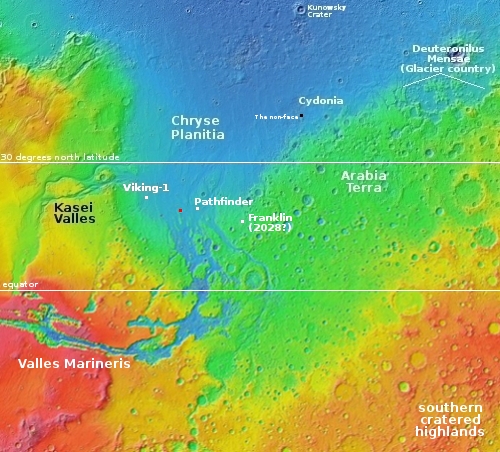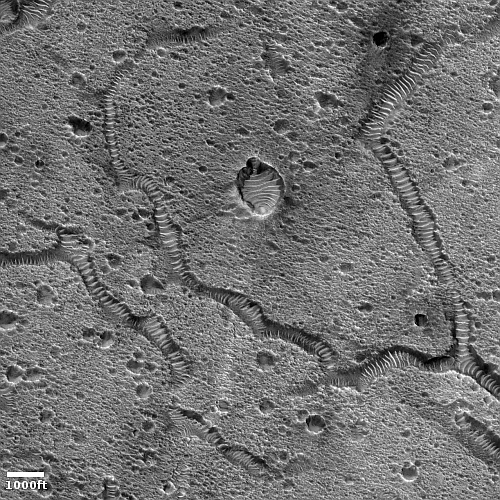A fractured spot in Mars’ northern lowland plains
Cool image time! The picture to the right, cropped, reduced, and sharpened to post here, was taken on February 16, 2023 by the high resolution camera on Mars Reconnaissance Orbiter (MRO). It shows a pockmarked flat plain with a scattering of meandering hollows, each filled with ripple sand dunes that make these depressions resemble at first glance the tracks of tires.
Obviously, we are not looking at evidence of a past giant vehicle moving across the ground on Mars. The MRO science team labels these “fractures,” suggesting some past geological process caused the surface to crack in this manner, with those cracks widening with time due to erosion or sublimation.
The location of course tells us something about that process.

The red dot on the overview map to the right, located about midway between the Viking-1 and Pathfinder landing spots, marks this location inside Chryse Planitia, the lowland plain at the outlet from the vast canyons Valles Marineris and Kasei Valles.
The location is in the dry equatorial regions of Mars where orbital images have found little or no evidence of near surface ice. Thus, this pockmarked surface is dry, though its location at the outlet to these two canyons suggests it was once inundated by the catastrophic floods that scientists presently theorize poured forth from those canyons several billion years ago. Those floods could have deposited water here which froze and even sank into the dust-covered ground, causing many ice droplets everywhere. Could the many small holes now indicate spots where that ice once existed, but as the equatorial regions dried out sublimated away?
Maybe, but that doesn’t explain the fractures. Nor have I any theory as to their formation.
On Christmas Eve 1968 three Americans became the first humans to visit another world. What they did to celebrate was unexpected and profound, and will be remembered throughout all human history. Genesis: the Story of Apollo 8, Robert Zimmerman's classic history of humanity's first journey to another world, tells that story, and it is now available as both an ebook and an audiobook, both with a foreword by Valerie Anders and a new introduction by Robert Zimmerman.
The print edition can be purchased at Amazon or from any other book seller. If you want an autographed copy the price is $60 for the hardback and $45 for the paperback, plus $8 shipping for each. Go here for purchasing details. The ebook is available everywhere for $5.99 (before discount) at amazon, or direct from my ebook publisher, ebookit. If you buy it from ebookit you don't support the big tech companies and the author gets a bigger cut much sooner.
The audiobook is also available at all these vendors, and is also free with a 30-day trial membership to Audible.
"Not simply about one mission, [Genesis] is also the history of America's quest for the moon... Zimmerman has done a masterful job of tying disparate events together into a solid account of one of America's greatest human triumphs."--San Antonio Express-News
Cool image time! The picture to the right, cropped, reduced, and sharpened to post here, was taken on February 16, 2023 by the high resolution camera on Mars Reconnaissance Orbiter (MRO). It shows a pockmarked flat plain with a scattering of meandering hollows, each filled with ripple sand dunes that make these depressions resemble at first glance the tracks of tires.
Obviously, we are not looking at evidence of a past giant vehicle moving across the ground on Mars. The MRO science team labels these “fractures,” suggesting some past geological process caused the surface to crack in this manner, with those cracks widening with time due to erosion or sublimation.
The location of course tells us something about that process.

The red dot on the overview map to the right, located about midway between the Viking-1 and Pathfinder landing spots, marks this location inside Chryse Planitia, the lowland plain at the outlet from the vast canyons Valles Marineris and Kasei Valles.
The location is in the dry equatorial regions of Mars where orbital images have found little or no evidence of near surface ice. Thus, this pockmarked surface is dry, though its location at the outlet to these two canyons suggests it was once inundated by the catastrophic floods that scientists presently theorize poured forth from those canyons several billion years ago. Those floods could have deposited water here which froze and even sank into the dust-covered ground, causing many ice droplets everywhere. Could the many small holes now indicate spots where that ice once existed, but as the equatorial regions dried out sublimated away?
Maybe, but that doesn’t explain the fractures. Nor have I any theory as to their formation.
On Christmas Eve 1968 three Americans became the first humans to visit another world. What they did to celebrate was unexpected and profound, and will be remembered throughout all human history. Genesis: the Story of Apollo 8, Robert Zimmerman's classic history of humanity's first journey to another world, tells that story, and it is now available as both an ebook and an audiobook, both with a foreword by Valerie Anders and a new introduction by Robert Zimmerman.
The print edition can be purchased at Amazon or from any other book seller. If you want an autographed copy the price is $60 for the hardback and $45 for the paperback, plus $8 shipping for each. Go here for purchasing details. The ebook is available everywhere for $5.99 (before discount) at amazon, or direct from my ebook publisher, ebookit. If you buy it from ebookit you don't support the big tech companies and the author gets a bigger cut much sooner.
The audiobook is also available at all these vendors, and is also free with a 30-day trial membership to Audible.
"Not simply about one mission, [Genesis] is also the history of America's quest for the moon... Zimmerman has done a masterful job of tying disparate events together into a solid account of one of America's greatest human triumphs."--San Antonio Express-News



Looks more like sand dunes to me. Some sort of wind process moving dry material thru canyons and craters.
Miner Clay: Yup, those are ripple sand dunes in the fractures. That doesn’t explain however what caused the fractures themselves.